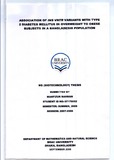Association of INS VNTR variants with type 2 diabetes mellitus in overweight to obese subjects in a Bangladeshi population
Abstract
Background and Aim: Diabetes is regarded as a public health problem all over the world including Bangladesh. Type 2 diabetes variety constitutes the major bulk of total diabetic patients. Obesity and insulin resistance were found to be associated with T2DM, which is now a day considered as component of metabolic syndrome. The present study was undertaken to determine INS VNTR variant genotype frequencies in type 2 diabetes mellitus in a Bangladeshi population and explore its association with obesity and insulin secretion. Subjects and Methods: A total number of 111 type 2 diabetic subjects and 251 healthy controls were recruited. Detailed clinical and anthropometric measurements were recorded. Oral glucose tolerance test was performed. Blood glucose was measured by glucose-oxidase, triglyceride, total cholesterol and HDL-cholesterol, and SGPT by enzymatic colorimetric, creatinine by alkaline picrate method. Insulin was estimated by enzyme linked immunosorbent assay (ELISA). DNA was extracted using commercially available Kits from QIAGEN which utilizes Silica gel DNA separation. INS VNTR j 7 variant was determined by PCR-RFLP using restriction endonuclease Hphl. Data were managed using Statistical Program for Social Science (SPSS). Unpaired Student's 't' test and Chi-squared tests were performed where appropriate. Results: The INS VNTR A>T genotype frequencies in the controls were 0.690, 0.254 and 0.056 for homozygous wild, heterozygous variants and homozygous variants respectively and, 0.731, 0.250 and 0.019 in the T2DM subjects which appeared to be of almost similar frequency. Absolute insulin level (mean±SD) between the Controls and T2DM did not show significant difference. Anthropomentric measurements, BMI and body fat mass did not show statistical significant difference between the Control and T2DM. Subjects with wild and variant genotype either in the Controls and T2DM did not show significant difference regarding circulating insulin, BMI and BFM. However, WHR was found to be significantly higher among subjects with variant INS VNTR genotype compared to those with wild in the Controls (p=.003). The difference in the T2DM did not reach to the level of significance (p=0.08). Conclusions: It was concluded that INS VNTR variant genotype: (i) frequencies are substantially different in Bangladeshi population compared to that of the Caucasoids; (ii) is not associated with circulating insulin in the controls and T2DM; (iii) is not associated with type 2 diabetes in Bangladeshi population; and (iv) seem to have an association with central obesity in our population.

